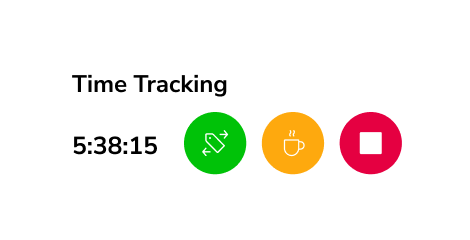Complete Guide to Desktop Time Tracking
Time tracking has come a long way over the years. It started with recording hours on paper, moved to spreadsheets, and then to early phone apps and web tools before settling into desktop software.
But what drives people to opt for desktop time tracking, and what advantages does it offer? The convenience factor is right there – it’s readily available on your computer, eliminating the need for fuss or hassle. It’s swift, precise, and flaunts additional features like offline functionality, ensuring your work data stays secure on your device.
This article will cover key topics about desktop time tracking. Whether you’re new to time tracking or looking to streamline your workflow, this guide covers the benefits, key features, and best practices for using desktop time tracking software.
What is Desktop Time Tracking?
Desktop time tracking software is a tool that helps you monitor and record the time spent on tasks or projects directly from your computer. Unlike web-based tools that you access through a browser, desktop time tracking requires downloading and installing software on your computer. Once installed, it usually sits on your taskbar or menu bar for quick access.
These tools often come with features like automatic time tracking to make logging hours easier. It also comes with expanded employee monitoring features like screenshot monitoring, URL and keyboard tracking, and app tracking.
Since the software is integrated into your desktop, it’s easy to manage your time without interrupting your workflow.
Desktop time tracking is useful for freelancers, remote workers, teams, and businesses looking to improve time management, track productivity, and ensure accurate billing. It provides real-time insights and helps you stay organized throughout your workday.
There’s also no need to stress about compatibility; desktop time tracking software is compatible with both Mac and Windows. So, no matter your computer choice, it smoothly becomes a part of your setup, making your work life easier without any extra hassle.
Difference Between Web and Desktop Time Tracking
The main difference between web and desktop time tracking software is how you access them. Web time tracking works through a browser and can be used on any device with internet access, making it ideal for remote teams and real-time collaboration. It also receives automatic updates, so you always have the latest features.
Desktop time tracking, on the other hand, requires installing an app on your computer and is designed for specific operating systems like Windows and macOS. It can track time even without an internet connection and often includes features like idle tracking and integration with other desktop apps.
Learn more about key differences from our Desktop vs. Web Time Tracking article.
5 Reasons Why You Need Desktop Time Tracking Software
Desktop time trackers can be a mighty tool for gaining better control over how time is spent. Here are the five ways they can improve your workflow:
- Enhanced efficiency and accountability: Desktop time tracking helps you see how you spend your time on different tasks, allowing you to identify and reduce time-wasting activities to boost productivity.
- Accurate payroll management: For businesses that bill by the hour, desktop time tracking ensures invoices match the actual hours worked, preventing underbilling or overbilling.
- Enhanced employee monitoring: Desktop time tracking provides real-time visibility into employee activities, allowing managers to monitor work hours, track progress, and identify potential productivity bottlenecks. This can be especially useful for tracking remote teams or those working on time-sensitive projects.
- Offline tracking capabilities: Unlike web-based tools, desktop time tracking software continues to log hours even without an internet connection. This ensures that no work hours are missed, even in areas with poor connectivity. Once reconnected, all logged data syncs automatically.
- Data-driven insights: Desktop time tracking software often includes reporting and analysis features that break down time spent on tasks, projects, or clients. This data can be used to assess project costs, measure team performance, and make more informed business decisions.
How to Set Up Desktop Time Tracking Software
Setting up Jibble’s desktop app is a simple process. Here are the steps to begin:
- Download and install the desktop app – Visit Jibble’s official website, download the desktop app, and follow the installation instructions to set it up on your Mac or Windows operating system.
- Sign in or create an account – Open the Jibble desktop app and sign in with your existing Jibble account or create a new one.
- Configure your preferences – Once logged in, access the app’s settings to customize your preferences. This may include choosing a language, allowing the app to launch on system startup and setting a default project, activity and location for clock-ins.
- Allow screenshot capture – If screenshot monitoring is required by your employer, adjust your privacy settings to allow screen capturing.
- Start tracking time – Initiate time tracking by clicking the Play icon within the app. Choose project, activity and location to ensure accurate time tracking and proper allocation of hours to specific tasks. At this stage you can also set an automatic clock-out or a clock-out reminder.
- Pause and resume – You have the option to pause the timer when taking breaks or stepping away from your computer. Simply resume tracking when you return to work.
- Clock out – To conclude your work session, click the Stop icon. This will stop the timer and record your total work hours.
- Automate your time tracking – Open settings to enable automatic clock ins and outs when you open and close the app. You can also set it to clock you out or start a break when your PC enters the sleep mode or locks, and clock you in when it wakes or unlocks.
- Explore additional features on web – Visit our web app with one click to see detailed timesheets and reports, manage time off and integrate with other tools.
What are the Features to Look for in Desktop Time Tracking?
When you’re looking at desktop time tracking options, there are some important features to keep in mind that can make your time management more effective:
- Offline mode – This is a must-have feature for situations where you might not always have a stable internet connection. It allows you to keep tracking your work hours even when the internet is unreliable.
- Screenshots – Time tracking with screenshots provides visual records of what you were working on at different times. This can be really useful for tasks where it’s important to keep a clear record of what you’ve been doing.
- Keyboard shortcuts for clocking in and out – These are shortcuts that let you quickly start and stop tracking your time. They save time by eliminating the need to enter everything manually.
- Automatic clock-ins and clock-outs – Some tools can start tracking your time automatically as soon as you turn on your computer or open the app. This makes sure you don’t forget to start tracking your work. More advanced apps allow setting up automatic clock-outs when the PC goes to sleep/locks, and automatic clock-ins upon waking/unlocking.
- Idle detection – This feature notices when you’re not actively using your computer and can pause the time tracking during breaks or when you step away. It helps you stay accountable for moments of inactivity and keeps your time records accurate.
- App usage tracking – App tracking shows you how you spend your time on different applications. This can be really helpful for seeing which apps you use the most and how these apps affect your productivity.
- Mouse clicks and keyboard strokes tracking – You get to identify productivity and usage patterns through mouse clicks and keyboard strokes. This feature records what you do with your mouse and keyboard, giving you detailed information on how you use your computer. It’s useful for understanding your work habits and how you manage your time.
Not sure where to start? Take a look at our list of Top 8 Time Tracking Apps for Mac and 8 Best Time Tracking Apps for Windows.
What’s Next for Desktop Time Tracking?
Time tracking has evolved from basic pen and paper to desktop software that makes it easier to track work hours and attendance. Modern time tracking tools do more than just log hours – they can provide insights into productivity, help manage projects, and simplify payroll.
As the technology improves, new features like automated tracking, idle detection, and reporting make it even more effective. Integrations with project management and payroll systems also make it easier to keep data connected and accurate.
In the future, we can expect to see more advanced features like AI-powered insights and task-specific timers that will make time tracking even more accurate and useful.
Related Articles:
How to Upgrade Desktop Time Tracking with Integrations
8 Best Practices for Desktop Time Tracking
Pros and Cons of Employee Monitoring


